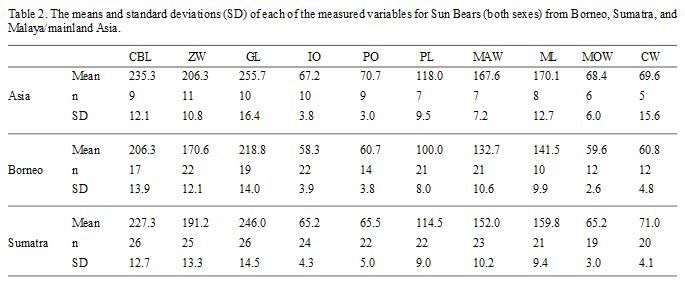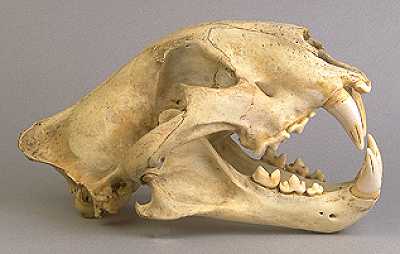|
|
Post by coherentsheaf on Jun 2, 2013 23:19:55 GMT 5
And the multibody-dynamics method produces overestimates for some and tremendous underestimates for others? what about this: Is it really the same as with the dry skull estimates? In Deinonychus, do you mean the estimate based on toothmarks? I heard of some gigantic figure for T. rex based on toothmarks, so they migutn produce overestimates in general. On the other hand the 2012 study stated the two previous, bite-mark based estimates were significantly lower than theirs. The problems comes from the fact that they claim sustained bite forces by Alligator to be much lower and go on to cite Erickson on that point. But Erickson simply does not say a thing about sustained forces in his papers. If I had been the reviewer the paper would ave been ejected for this. |
|
|
|
Post by Vodmeister on Jun 3, 2013 6:49:49 GMT 5
Feline vs Ursine
“Bite Club: comparative bite force in big biting mammals and the predatory behavior in fossil taxa”, by Stephen Wroe, Colin McHenry, and Jeffrey Thomason (from 2005):  Comparing the brown bear to a lion or tiger of equal weight according to this study: Tigers bite 63% harder. Lions bite 44% harder. “Bite forces and evolutionary adaptations to feeding ecology in carnivores” by Per Christiansen and Stephen Wroe (from 2007):  Comparing the brown bear to a lion or tiger of equal weight according to this study: Comparing the brown bear to a lion or tiger of equal weight according to this study:Tigers bite 31% harder. Lions bite 25% harder. “Bite force of the extinct cave bear Ursus spelaeus Rosenmueller from Europe”, by Aurora Grandal-d'Anglade:  950 N for a 225 kg brown bear. 1850 N for a 150 kg tiger. 1850 N for a 175 kg lion. ((1850*(225/150)(2/3))/950)-1)*100% = 155% ((1850*(225/175)(2/3))/950)-1)*100% = 130% According to this study a tiger the same size as the brown bear would bite 155% harder, and a lion 130% harder (note, this means well over twice as hard!). Also note the upper canine lengths:  Brown bear: 38.6 mm Lion: 60.0 mm Tiger: 61.0 mm The canines must of course also have the strength...  The canines of the felines are just as strong relative to their (higher) bite forces as those of bears. Thus, when a brown bear fights a parity lion or tiger, it is fighting an animal with a bite 25% to 155% harder and much longer canines of at least equal strength. This seems like something someone needs to consider very heavily. Check this out - the skull of a 550lb lion compared to the skull of a 550lb black bear:   This is what cat vs. bear parity looks like with regards to the skulls and teeth. Skull size (and gape, + bite force to a lesser extent) do influence how easily one animal can overpower another. This can be seen with the extinct creodont carnivorous mammals (specifically the hyenadont family, like hyenadon horridus) - they had no grappling ability (and not much in the way of intelligence) but they were able to overpower prey with a huge head, wide gape, strong jaws and teeth designed for killing.
|
|
|
|
Post by Runic on Jun 3, 2013 7:21:26 GMT 5
Ummmmmm....... No.  Th differenc is no where near as huge. Bear have longer skull than cats,while cats have sligtly more massive skulls. However sun bear have extremely massive heads(From chui)   Sun bears have skulls in size comparable to jaguar and lion despite being much smaller. More on bear bite though.   |
|
|
|
Post by Vodmeister on Jun 3, 2013 8:09:28 GMT 5
 That picture is quite telling, actually. Although the two skulls are about equal in length, the Tiger has a clearly more massive build skull than the Bear. The Tiger's skull design has more volume, and the canines are both thicker and longer. |
|
|
|
Post by Runic on Jun 3, 2013 8:16:06 GMT 5
Ummm no sir, the bear skull is clearly longer, look at where they end.  The bears skull is clearly longer. The tigers skull is just marginally wider. Much better comp then that biased black bear/lion skull comp dinocruta made that led to the belief a cat/bear skull comparison is like comparing the size of a hurricane to a tornado! I don't know what your talking about but the canines of the tiger are only longer. |
|
|
|
Post by Vodmeister on Jun 3, 2013 8:18:27 GMT 5
Now look at where they start, the top of the Tiger skull is higher than the top of the Grizzlies skull.
Even if the Bear's skull is slightly longer, you have to remember that usually, Brown Bears are larger animals than Tigers. At parity, the length of a Tigers skull is at least as long as a Bears skull, and obviously much more impressively build.
They are also thicker, mate.
|
|
|
|
Post by Runic on Jun 3, 2013 8:21:08 GMT 5
It's 3 dimensional, not 2 dimensional. What you are seeing is something called height, not length. Look again.  Oh really? The comp says grizzly OR brown bear as in its the same species just they put both names in. What was that I remember you saying? Grizzly are no bigger than lions? At parity bears, like canids, have longer skulls than cats. That's a general fact. I don't know what canines you seem to be looking at then. |
|
|
|
Post by Vodmeister on Jun 3, 2013 8:27:34 GMT 5
The snout of the Bear is only slightly ahead of the Tigers snout. However, you cannot prove that they are positioned equally, as you said, you can't see the back of the picture, therefore you cannot assume that the Bear's skull is longer.
I said that a Mountain Grizzly is no larger than a Bengal Tiger. Your picture does not specify what type of Brown Bear it is, nor does it specify the type of Tiger, and most importantly, it doesn't even claim that both animals were equal in size. Therefore, you can't simply assume that this picture comparison were of two animals at parity.
The four at the front?
|
|
|
|
Post by Vodmeister on Jun 3, 2013 8:29:57 GMT 5
Black Ice, by the way, to make a signature, you go to Profile ? Edit Profile ? Personal.
Just to put it out there, as you were asking it in the chat.
|
|
|
|
Post by Runic on Jun 3, 2013 8:36:58 GMT 5
grizzly skull    Tiger skull  Even if their not to scale you can see clear as day the bear has a more elongated skull. Nope i remember the thread you rebuked ursus panthera on clear as day. You just said grizzly.  It's a grizzly, or "Brown bear" as the common public know it. does it really matter? The comp is still much better than that biased one dinocruta made. Grizzly aren't bigger than lions remember? So instead we use that biased comp between a large lion and a black bear that was most likely fat as they rarely ever even get close to 500lbs? OH lol I was looking at something else. EDIT: Yea thanks for the sig help! |
|
|
|
Post by Vodmeister on Jun 3, 2013 8:44:30 GMT 5
That does not prove a stronger bite. If anything, it is the more robust skull which is generally the more powerful one.
A Grizzly Bear is referred to the Ursus Arctos which live in mountain/innerland regions. A Brown Bear is named after the Ursus Arctos whom live in Coastal regions.
Mountain Grizzlies are about equal in size to Tigers and Lions, Coastal Brownies are not. Your picture does not specify what type of Brownie was used, therefore you can't assume that it was a Grizzly.
Also, coastal Brownies out-number mountain species, so there's a bigger chance that the Bear was a coastal specimen rather than a mountain specimen.
Another problem with your picture, is that it does not specify the subspecies of Tiger either. Was it a Bengal or Siberian Tiger? Was it a smaller Tiger such as the Indo-Chinese or Sumatran Tiger? It's not labelled, so you cannot assume.
Black Bears are actually just as likely as Lions to get 500 pounds, though on average they are much smaller. They have a much greater size range.
|
|
|
|
Post by Runic on Jun 3, 2013 8:44:32 GMT 5
Vodmeister
I already know that the skull of a cat is generally superior to a bear. My only problem with your post was that biased size comp made by Dinocruta.
|
|
|
|
Post by Vodmeister on Jun 3, 2013 8:46:08 GMT 5
Ah, OK.
Yeah, I'll use the better size comp next time.
|
|
|
|
Post by Runic on Jun 3, 2013 8:52:41 GMT 5
Ah, OK. Yeah, I'll use the better size comp next time. Ignore my last post then lol better yet ill just delete it. |
|
|
|
Post by creature386 on Jun 3, 2013 19:51:16 GMT 5
I tried to post that image in the OP, for some reason it didn't turn up. Now it does however. |
|





















